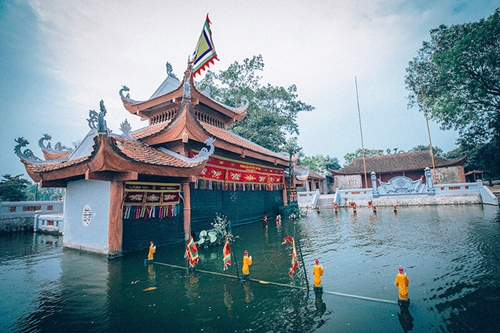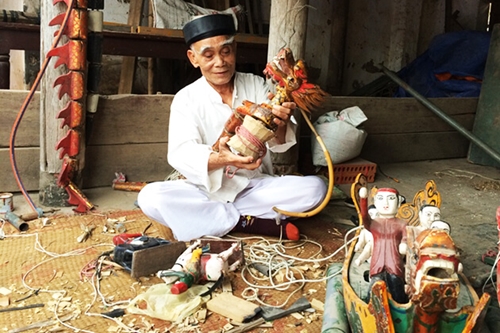In an article written for the People’s Army Newspaper’s Tet (lunar New Year) edition, Prof., Dr. Tu Thi Loan revealed that water puppetry uses the water surface as a stage. Water is not only a place where puppets perform, but also an element of alliance, symbiosis, and resonance. The water surface is both an environment and a supporting factor for puppets to show off their magical, vivid, surprising and mysterious performances to audiences. Thanks to the skillful and talented control of artisans, the puppets - inanimate objects come to life like soulful beings.
    |
 |
|
Water puppet performance in Rach village of Hong Quang commune, Nam Truc district, Nam Dinh province |
According to Prof. Loan, water puppetry is an art of combination of stories, songs, dances, music, acting, antics, dialogues, orchestra, sounds including that of firecracker, lighting, and more, creating strong and attractive effects to viewers. Attentively, through water puppetry, viewers could learn more about literary stories, customs, excerpts of cheo (popular opera) and tuong (classical drama), folk songs, and proverbs.
Legend has it that water puppetry was born when An Duong Vuong built Co Loa Citadel in 255 B.C. However, based on collected evidence, water puppetry was popular in Vietnam under the Ly Dynasty. This kind of art has been refined and perfected to become a unique traditional art of stage of the nation.
Dao Thuc, Te Tieu, Trang Son, Binh Phu, Thach Xa, Nguyen Xa, Nam Chan, Thanh Hai, Ra are typical puppet villages in Vietnam. These are old and famous puppet villages lying around Thang Long Citadel and the Red River delta.
The art of water puppetry is the crystallization of creativity, intelligence and skills of Vietnamese farmers for generations. It features daily life of farmers, such as planting, ploughing, tending and catching ducks, fishing, pounding rice. It also depicts festivals as dragon dance, lion dance, palanquin procession, wrestling, martial arts, buffalo, cock fighting, boat racing, swimming, swinging; and praises national heroes in the struggle against foreign invaders such as Trung Sisters, Le Loi, Tran Hung Dao.
    |
 |
|
A water puppetry artisan of Rach village |
Over the past two decades, water puppetry has developed strongly with more diverse, interesting, lively acts and topics combined with effects of the modern stage.
In depth of vitality and cultural identity of Vietnam, water puppetry has been attractive to the public, especially foreign tourists.
Prof. Loan gave the fact that the Vietnam National Puppetry Theater, Thang Long Water Puppet Theater have performed water puppetry in nearly 100 countries. Notably, the Thang Long Water Puppet Theater was honored with the title of “the only theater in Asia performing 365 days a year.”
In fact, most of foreign audiences are surprised and show their admiration for Vietnam's water puppetry. The French call it "the soul of the Vietnamese field" and consider water puppetry one of the most important forms of the world puppetry. In Vietnam, the water puppetry show is included in almost all tours for foreigners. That is the fame of professional water puppetry stages.
In contrast, water puppetry villages are shrinking and operating meagerly due to the change in living conditions and increasing demand in creativity and cultural enjoyment. The art of water puppetry in Ra village, for example, used to be very popular and was closely attached to tourism. The villagers have many times performed abroad. However, due to the lack of management skills, methodical development strategy and the building of a contingent of competent successors, this kind of art in this village has declined.
Therefore, in order to preserve and promote the art of water puppetry as a national unique cultural heritage, it requires a vision, investment, and proper approaches.
Prof. Loan cited Indonesia as an example for Vietnam. The government of Indonesia built a dossier on Wayang puppet theater to submit to UNESCO for recognition as a heritage. The country’s efforts were paid off in 2003 when UNESCO proclaimed Wayang puppet theater as “Masterpiece of the Oral and Intangible Heritage of Humanity.”
Since the UNESCO’s proclamation, the Indonesian art of puppetry has gradually revived and been performed regularly for tourists. In addition, puppets are made as souvenirs and cultural symbols. So far, Wayang shadow puppetry has become an attractive tourist product that lures more tourists to the country.
According to Prof. Loan, comprehensive measures should be carried out to develop Vietnam’s water puppetry sustainably. First, information dissemination should be boosted to raise the public’s awareness of water puppetry because this specialty of Vietnamese culture is not quite popular among local people. Second, more lessons on water puppetry - the heritage should be given to younger generation. The education could be integrated in programs such as “school theater,” “bringing heritage to schools.” Third, more care should be paid to artisans and practitioners of water puppetry. Encouragement mechanisms and policies should be also adopted for local clubs, water puppetry villages so that the passing down of the quintessence of such a heritage will be enhanced. Importantly, the building of a dossier on water puppetry to submit to UNESCO for recognition as the Intangible Cultural Heritage of Humanity should be put forth early. No locality in Vietnam has volunteered to make a national dossier on water puppetry yet.
Finally, it needs investment for scriptwriters and artists to create more attractive performances to catch viewers’ attention.
The art of water puppetry will last forever with the national culture if it receives due attention and joint efforts and contribution from management agencies, policy makers, water puppetry-involved individuals and communities. With this done, younger generations will enjoy, inherit and pass down the quintessential values of this precious cultural heritage to many generations to come.
Translated by Mai Huong